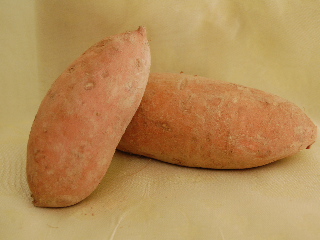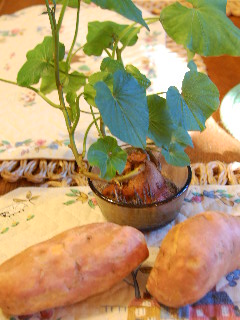
Here we go again—down the garden path we’ve traveled before—to that familiar place where we find another easy to grow and healthy to eat garden goodie.
Today, as we reach our destination we find the very humble looking, but bursting with nutrition, sweet potato.
A whole new crop of sweet potatoes can be grown from cuttings taken from the mature sweet potatoes that you buy in the grocery store. However, if you hope to produce a crop of disease-resistant, nice-sized, nutritious, tasty sweet potatoes, it’s best to buy your slips (actually small bare-rooted plants) from a reliable source such as the farm supply store or order them from a reputable dealer such as the Burpee® Company.
Plant the slips in the spring of the year as the ground starts to warm and after all danger of frost has past. Allow 12” to 18” between plants as they will form vines that need room to run and spread.
Sweet potato vines need full-sun, a loamy organic soil, and regular rainfall in order to grow plenty of sizeable sweet potatoes. Of these three requirements, plenty of sunshine and moisture are the two most important—sweet potato vines will actually tolerate less-than-desirable soil conditions, but the potatoes they produce will be of a smaller size.
If growing conditions are favorable throughout the season, it will take about 100 days from time of planting until the sweet potatoes are ready to harvest. By this time, the leaves are probably starting to turn yellow.
Use a round-point shovel to carefully dig around the plants and unearth the mature tubers that have formed just below the surface of the ground on the roots of the sweet potato plants.
Allow the freshly dug sweet potatoes to air-dry for a short time and them store them in a cool (but not refrigerated) place. They should keep fresh and be useable for several months.

Now, on to the good part—consuming the crop! Sweet potatoes are another of those ridiculously loaded with nutrition super foods.
These unassuming little vegetables with the sometimes grotesquely asymmetrical shapes are a great source of Vitamin A, Vitamin C, Vitamin B6, manganese, copper, and iron.
Sweet potatoes are rich in antioxidants that help eliminate those nasty old free radicals that are often associated with the development of cancer, diabetes, and heart disease. In addition, sweet potatoes are high in dietary fiber while being relatively low in calories per serving.
One of the easiest ways to prepare sweet potato is simply to bake it (with skin still on) like any other baked potato and serve it topped with a little bit of butter or cinnamon. Or, slice the potatoes into small pieces and boil in a covered pot with a little bit of water.
A favorite Southern dish is prepared by baking sweet potato into a casserole with some brown sugar added and then topped with miniature marshmallows. Bits of fresh pineapple or shredded coconut are often added to this dish, too. Any way you choose to serve it, sweet potato is a deliciously nutritious food to add to your menu.
And, finally—for a funny little bit of unusual greenery—try growing a sweet potato slip in water in a clear glass container to decorate your dining table or kitchen window.
 Here we go again—down the garden path we’ve traveled before—to that familiar place where we find another easy to grow and healthy to eat garden goodie.
Here we go again—down the garden path we’ve traveled before—to that familiar place where we find another easy to grow and healthy to eat garden goodie.
 Now, on to the good part—consuming the crop! Sweet potatoes are another of those ridiculously loaded with nutrition super foods.
Now, on to the good part—consuming the crop! Sweet potatoes are another of those ridiculously loaded with nutrition super foods.